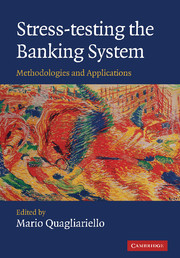Book contents
- Frontmatter
- Contents
- List of figures
- List of tables
- List of boxes
- List of contributors
- Foreword
- Acknowledgements
- Introduction
- Part I Fundamentals
- 1 A framework for assessing financial stability
- 2 Macroeconomic stress-testing: definitions and main components
- 3 Macroeconomic stress-testing banks: a survey of methodologies
- 4 Scenario design and calibration
- 5 Risk aggregation and economic capital
- 6 Data needs for stress-testing
- 7 Use of macro stress tests in policy-making
- Part II Applications
- Conclusions
- Index
- References
5 - Risk aggregation and economic capital
from Part I - Fundamentals
Published online by Cambridge University Press: 18 December 2009
- Frontmatter
- Contents
- List of figures
- List of tables
- List of boxes
- List of contributors
- Foreword
- Acknowledgements
- Introduction
- Part I Fundamentals
- 1 A framework for assessing financial stability
- 2 Macroeconomic stress-testing: definitions and main components
- 3 Macroeconomic stress-testing banks: a survey of methodologies
- 4 Scenario design and calibration
- 5 Risk aggregation and economic capital
- 6 Data needs for stress-testing
- 7 Use of macro stress tests in policy-making
- Part II Applications
- Conclusions
- Index
- References
Summary
Introduction
Risk aggregation represents one of the major challenges for stress tests. It is also a topic where the interconnections between macro stress-testing and banks' risk management practices are clear, particularly when bottom-up approaches are used for stress-testing the banking system.
In recent times, banks have been giving greater emphasis on the management of risk on an integrated firm-wide basis and, also, have been making efforts to aggregate different risk types through quantitative risk models (Basel Committee on Banking Supervision, 2003). Such trends have been influenced by and, simultaneously, have influenced the supervisory practices. The improvements of the techniques for risk aggregation have also led to significant advances in the methodologies for prudential and macroeconomic stress-testing, providing tools for assessing the joint impact of several risks.
Indeed, the development of more sophisticated risk management approaches ensures both a better measurement and control of risks and, most of all, a deeper understanding of the relations among them. An integrated risk management system favours a better estimate of the overall risk undertaken and supports the research of sound measures of risk aggregation, such as economic capital.
Risk aggregation is the process of merging different risk types into a single metric. It represents a preparatory procedure to assess the economic capital. Economic capital is the capital that shareholders should invest in the bank in order to limit the probability of default to a given confidence level over a specified time horizon.
- Type
- Chapter
- Information
- Stress-testing the Banking SystemMethodologies and Applications, pp. 80 - 98Publisher: Cambridge University PressPrint publication year: 2009



